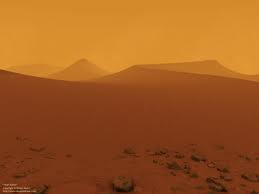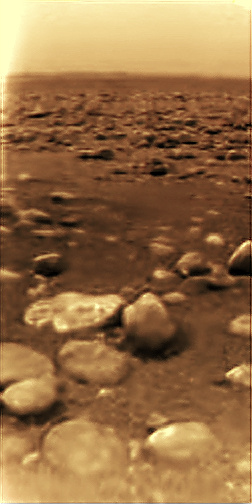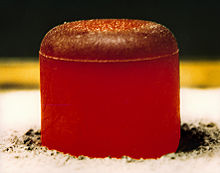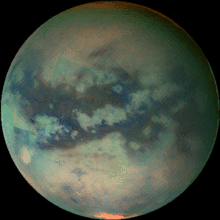Awakened After 7 Years in Space – Huygens Lands on Titan
January 14, 2005: Huygens Lands on Titan
After traveling nearly 7 years through the darkness of space the Huygens probe lands safely on the surface of Titan, Saturn’s largest moon. This was the first landing ever accomplished in the outer solar system. Based on pictures taken by the orbiter Cassini at 1,200 km away from Titan, the landing site appeared to be a shoreline. Huygens was designed to survive the impact, whether it was a solid or a liquid surface on Titan.
The spacecraft had no more than three hours of battery life, most of which was planned to be taken up by the descent. It touched down on land, and continued to send data for about 90 minutes after touchdown.
It was the most distant landing of any man-made craft.
________________________________________________

 On October 15, 1997, Cassini–Huygens was launched from Cape Canaveral. The Huygens probe was named after the 17th century Dutch astronomer Christian Huygens who first discovered Titan. It was designed to enter and brake in Titan’s atmosphere and parachute a fully instrumented robotic laboratory down to the surface.
On October 15, 1997, Cassini–Huygens was launched from Cape Canaveral. The Huygens probe was named after the 17th century Dutch astronomer Christian Huygens who first discovered Titan. It was designed to enter and brake in Titan’s atmosphere and parachute a fully instrumented robotic laboratory down to the surface.
The Huygens probe remained dormant throughout the 6.7-year interplanetary cruise, except for semiannual health checks.
Huygens detached from the orbiter and coasted in free space to Titan in 22 days with no systems active except for its wake-up timer. The main mission phase was a parachute descent through Titan’s atmosphere. The batteries and all other resources were sized for a mission duration of 153 minutes, figuring a descent time of 2.5 hours and hopefully a half hour or more on Titan’s surface.
The probe’s radio link was activated early in the descent phase and the orbiter Cassini “listened” to the probe for the next 3 hours, including the descent phase, and the first thirty minutes after touchdown.
After landing, Huygens photographed a dark plain covered in small rocks and pebbles, which are composed of water ice. The two rocks just below the middle of the image on the right are smaller than they may appear: the left-hand one is 15 centimeters across, and the one in the center is 4 centimeters across, at a distance of about 85 centimeters from Huygens. There is evidence of erosion at the base of the rocks, indicating possible fluvial activity. The surface is darker than originally expected, consisting of a mixture of water and hydrocarbon ice. The assumption is that the “soil” visible in the images is precipitation from the hydrocarbon haze above.
Huygens photographed pale hills with dark “rivers” running down to a dark  plain. Current understanding is that the hills are composed mainly of water ice. It is thought that dark organic compounds created in the upper atmosphere by the ultraviolet radiation of the Sun may rain from Titan’s atmosphere. They are then washed down the hills with the methane rain and deposited on the plains over geological time scales.
plain. Current understanding is that the hills are composed mainly of water ice. It is thought that dark organic compounds created in the upper atmosphere by the ultraviolet radiation of the Sun may rain from Titan’s atmosphere. They are then washed down the hills with the methane rain and deposited on the plains over geological time scales.
Now that Cassini is orbiting Saturn, it is between 8.2 and 10.2 astronomical units (an astronomical unit is about 93 million miles) from the Earth. Because of this, it takes between 68 to 84 minutes for radio signals to travel from Earth to the spacecraft, and vice-versa.
Cassini is powered by 32.7 kg of plutonium-238—the heat from the material’s radioactive decay is turned into electricity. Huygens was supported by Cassini during cruise, but used chemical batteries when independent.
_________________________________________________
Titan is the largest moon of Saturn (larger in volume than Mercury) and the only natural satellite known to have a dense atmosphere and for which there is clear evidence of stable bodies of surface liquid. Titan is mostly composed of water ice and rocky material with many liquid hydrocarbon lakes in the polar regions. With Titan’s atmosphere being twice as thick as Earth’s it is difficult for instruments to image its surface.










